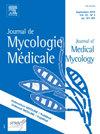A one health perspective on Diutina catenulata: Phenotypic traits, stress sensitivity, and virulence across diverse isolates
IF 1.8
4区 医学
Q3 MYCOLOGY
引用次数: 0
Abstract
Diutina catenulata, formerly Candida catenulata, is found in diverse substrates, including soil, food, animals, and humans. It is recognized as an emerging human pathogen responsible for various diseases, including invasive infections in susceptible hosts, particularly in immunocompromised individuals. This study aimed to assess the phenotypic profiles, in vitro responses to various stressful conditions, and in vivo virulence of D. catenulata isolates from different origins (human, veterinary, and environmental). In vitro antifungal susceptibility to fluconazole, voriconazole, micafungin and amphotericin B was also determined for all isolates. Most D. catenulata isolates exhibited a light blue coloration on CHROMID® Candida agar. Different profiles were observed on the Spider medium, suggesting different behavior among the isolates. All isolates of D. catenulata were highly sensitive to oxidative and osmotic stress as demonstrated by exposure to H2O2 and 1.5 M NaCl, respectively whereas no unique pattern was evidenced concerning the response to cell wall stressors or membrane stressors. In addition to acquired azole resistance for some isolates, these findings provide valuable insights into the strain-dependent responses of D. catenulata to various stress factors. Using Galleria mellonella, we highlighted a wide range of virulence profiles among the isolates. Overall, this research demonstrates that the observed responses are strain-dependent rather than sample-source-dependent.
从一个健康的角度来看,在不同的分离株中,毛毛蝶的表型特征、应激敏感性和毒力。
连环假丝酵母(Diutina catenulata),原名连环假丝酵母(Candida catenulata),存在于土壤、食物、动物和人类等多种基质中。它被认为是一种新出现的人类病原体,可导致各种疾病,包括易感宿主,特别是免疫功能低下个体的侵袭性感染。本研究旨在评估来自不同来源(人类、兽医和环境)的D. catenulata分离株的表型特征、对各种应激条件的体外反应和体内毒力。同时测定各菌株对氟康唑、伏立康唑、米卡芬净和两性霉素B的体外抗真菌敏感性。大多数catenulata菌株在CHROMID®假丝酵母琼脂上呈浅蓝色。在蜘蛛培养基上观察到不同的分布,表明不同菌株的行为不同。在H2O2和1.5 M NaCl环境下,所有菌株对氧化胁迫和渗透胁迫均表现出高度敏感,而细胞壁胁迫和膜胁迫均无独特的响应模式。除了一些菌株获得性抗唑外,这些发现还为线虫对各种应激因子的菌株依赖性反应提供了有价值的见解。利用mellonella Galleria,我们在分离株中强调了广泛的毒力概况。总的来说,这项研究表明,观察到的反应是菌株依赖,而不是样品来源依赖。
本文章由计算机程序翻译,如有差异,请以英文原文为准。
求助全文
约1分钟内获得全文
求助全文
来源期刊
CiteScore
5.10
自引率
2.80%
发文量
68
审稿时长
6-12 weeks
期刊介绍:
The Journal de Mycologie Medicale / Journal of Medical Mycology (JMM) publishes in English works dealing with human and animal mycology. The subjects treated are focused in particular on clinical, diagnostic, epidemiological, immunological, medical, pathological, preventive or therapeutic aspects of mycoses. Also covered are basic aspects linked primarily with morphology (electronic and photonic microscopy), physiology, biochemistry, cellular and molecular biology, immunochemistry, genetics, taxonomy or phylogeny of pathogenic or opportunistic fungi and actinomycetes in humans or animals. Studies of natural products showing inhibitory activity against pathogenic fungi cannot be considered without chemical characterization and identification of the compounds responsible for the inhibitory activity.
JMM publishes (guest) editorials, original articles, reviews (and minireviews), case reports, technical notes, letters to the editor and information. Only clinical cases with real originality (new species, new clinical present action, new geographical localization, etc.), and fully documented (identification methods, results, etc.), will be considered.
Under no circumstances does the journal guarantee publication before the editorial board makes its final decision.
The journal is indexed in the main international databases and is accessible worldwide through the ScienceDirect and ClinicalKey platforms.

 求助内容:
求助内容: 应助结果提醒方式:
应助结果提醒方式:


